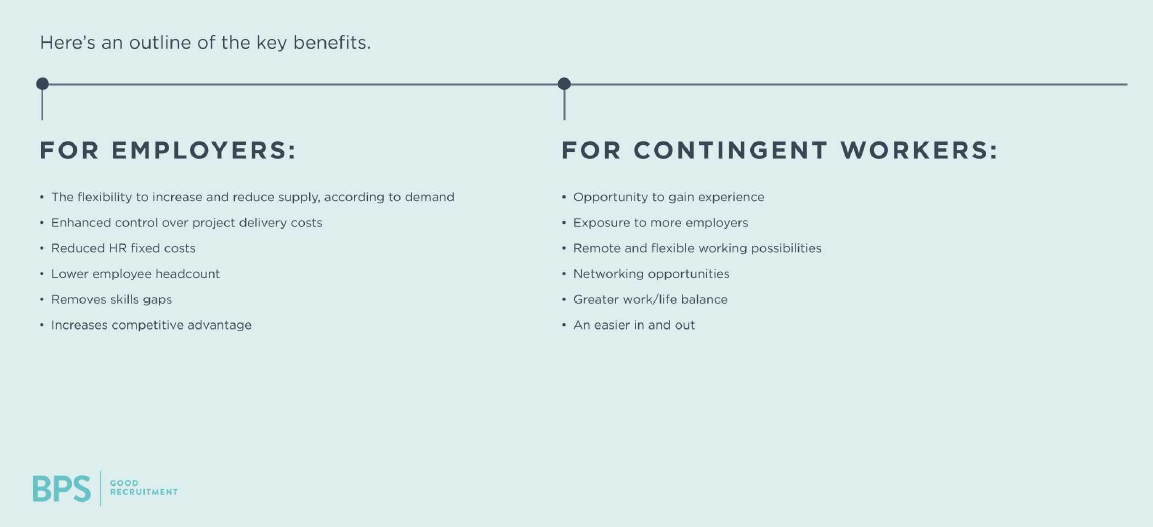Recruitment, Compliance / What are the benefits and risks of the contingent workforce?

Simon Conington
February 20, 2019
The shape of the modern workforce is changing. The use of contingent labour is on the rise. According to Deloitte’s 2018 Global Human Capital Trends study, 50% of businesses are using a significant number of contractors.
Meanwhile, only 42% of organisations are staffed primarily by salaried employees.There’s a fundamental shift taking place.
Our world is technology-driven, digitally connected and mobile savvy.
These conditions have generated an increasing demand for more flexible working arrangements and the freedom to perform meaningful work on a project basis.
“Most Companies are going to have to let go of their traditional thinking that everybody has to be a full-time employee.” – Josh Bersin, global HR thought leader, principal and founder of Bersin by Deloitte.
And now there’s a twin dynamic at play. Businesses are seizing new opportunities and reaping the rewards of an agile workforce.
However, this change has also posed challenging questions surrounding legislative, regulatory and financial compliance.
Procurement and Human Resources teams need to align and reconsider their approaches to risk.
Some are successful. But an alarming number of companies still lack the visibility, transparency and operational expertise required to guard against threats.
That’s the current landscape we’re operating in.
Now we’re going to examine the benefits and risks of using contingent labour.
What are the benefits?
The contingent workforce has grown as both employers and employees have adopted more flexible relationships.

What are the risks?
The contingent workforce is growing in importance and size. However, many organisations are struggling to manage this shift effectively.

Operational Risks
Inefficient management of a contingent workforce can have a detrimental impact upon business operations.
Inconsistencies can arise when there are multiple hiring managers involved in the recruitment of the contingent workforce.
Negotiating power can be diminished, costs can escalate, the ability to scale requirements is impaired and there’s a danger you'll lose visibility of the size of your contingent workforce.
Ultimately, failure to mitigate against these operational risks leads to an inability to control quality.
Financial Risks
Not having the right processes in place exposes a business to significant commercial risk and the threat of penalties and fines.
Inadequate contingent workforce management also leads to cost inefficiencies associated with having to overpay for talent.
Information Risks
The leaking of confidential data can be seriously damaging to a company’s brand and reputation.
Failure to adequately manage a contingent workforce increases the possibility of security breaches, as well as intellectual and property theft.
Legislative Risks
Misclassifying contingent workers and a failure to properly on-board these employees puts businesses at risk of legislative repercussions.
According to research from Deloitte, only 17% of UK companies have policies and strategies in place for the use of ‘non-traditional’ labour such as freelancers, contractors and gig workers’.
Meanwhile, the Criminal Finance Act 2017 has placed increased scrutiny on tax evasion across employees and ‘Associated Personas’, especially those engaged with a contingent workforce.
The Procurement-HR Relationship
Many businesses have two function groups tasked with managing the contingent workforce – Procurement and Human Resources.
Procurement teams have traditionally focused on cost-savings within the contingent workforce.
Meanwhile, HR have viewed contingent workers as an opportunity to attract and retain talent.
This relationship can often be harmonious.
However, having multiple functions focussed on contingent recruitment can lead to inefficiencies in delivery.
Typically, problems will occur when these two functions fail to align on strategic objectives.
To alleviate these concerns, an increasing number of businesses are turning towards third-party vendors to act as conduits between Procurement and Human Resources teams.
These suppliers will engage with both Procurement and HR to understand each departments’ requirements and deliver a solution that meets both parties’ expectations.
Want to learn more?
Download our guide to managing risk and compliance in the contingent workforce.
Or keep an eye out for our next blog where we’ll be examining what a compliant model looks like and the best ways to protect your business.


